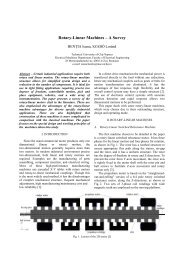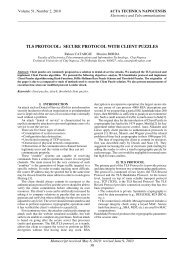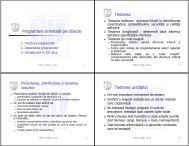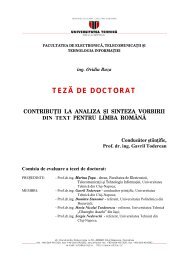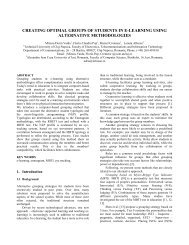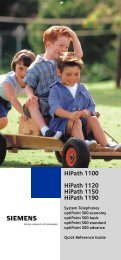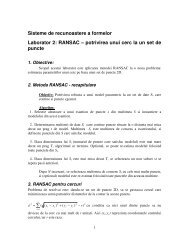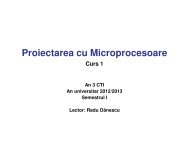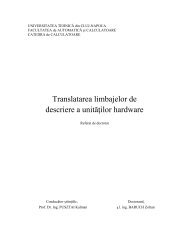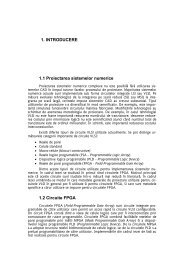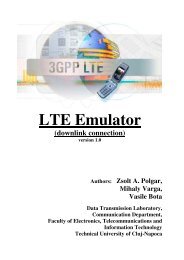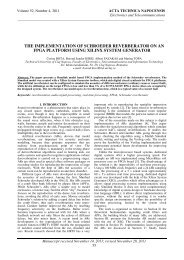PRACTICAL ASPECTS OF THE INTERCONNECTION BETWEEN ...
PRACTICAL ASPECTS OF THE INTERCONNECTION BETWEEN ...
PRACTICAL ASPECTS OF THE INTERCONNECTION BETWEEN ...
Create successful ePaper yourself
Turn your PDF publications into a flip-book with our unique Google optimized e-Paper software.
<strong>PRACTICAL</strong> <strong>ASPECTS</strong> <strong>OF</strong> <strong>THE</strong> <strong>INTERCONNECTION</strong><br />
<strong>BETWEEN</strong> ATM SWITCHES<br />
Virgil Dobrota 1 , Kalman Pusztai 2<br />
Daniel Zinca 1 , Emil Cebuc 2<br />
1 Technical University of Cluj-Napoca, Department of Communications,<br />
26 Baritiu Street, 3400 Cluj-Napoca, Romania,<br />
phone/fax: +40-64-191689, e-mail: {Virgil.Dobrota, Daniel.Zinca}@com.utcluj.ro<br />
2 Technical University of Cluj-Napoca, Department of Computer Science,<br />
26 Baritiu Street, 3400 Cluj-Napoca, Romania,<br />
phone/fax: +40-64-194835, e-mail: {Kalman.Pusztai, Emil.Cebuc@cs.utcluj.ro<br />
Abstract- This paper presents the results of practical work carried out to integrate ATM<br />
switches within the CAMAN (Cluj-Napoca Academic Metropolitan Area Network), the<br />
first ATM network in Romania. The equipment involved for two of four nodes were based<br />
on CoreBuilder 9000 (3Com) and VIRATAswitch 1000 (ATML), integrated into the 155<br />
Mbps optical fiber ring with other two APEX (General DataComm) - based switching<br />
systems. The first part is focused on system's design and configuration, followed by a<br />
description of the experimental results in the second part, including protocols like Classical<br />
IP over ATM and LAN Emulation services (ATM Forum or proprietary solutions).<br />
A. Introduction<br />
I. Cluj-Napoca Academic Metropolitan Area Network (CAMAN)<br />
In 1996 the Consortium of the Universities from Cluj-Napoca agreed to implement an<br />
ATM-based metropolitan area network in order to interconnect all their 39 sites. The<br />
funding for the infrastructure was supplied by the Ministry of Education, whilst the project<br />
was done by the Cluj Branch of RomTelecom S.A one year later. In 1998 the constructor<br />
was selected on a bidding basis, so Teleconstructia S.A. finished to install the 28 km.<br />
single-mode optical fiber infrastructure by the end of December 1998. The supplier for the<br />
passive components was M.T.IL Technologies and Systems.<br />
The paper is focused on practical work carried out to integrate two of the four ATM<br />
switches within this 155 Mbps high performance MAN.<br />
B. The CAMAN architecture<br />
Figure 1 presents the CAMAN architecture, including four main nodes, depicted as<br />
follows: node A (RoEduNet Administration Office, placed in Baritiu Street, providing the
general management of the system and the Internet access), node B (“Babes-Bolyai”<br />
University), node C (“Iuliu Hatieganu” Medicine and Pharmacy University) and node D<br />
(Technical University of Cluj-Napoca, at Observator Street site). Due to the fact that the<br />
funding for the active equipment was provided from several sources during different stages<br />
of the project implementation, the ATM switches that had to be installed were not supplied<br />
by the same manufacturer. Node A and Node B got technical support from Ericsson<br />
Romania to install APEX from General DataComm, Node C chose VIRATAswitch 1000<br />
from Advanced Telecommunications Modules Ltd. (through Alcatel Bell) and finally Node<br />
D preferred CoreBuilder 9000 from 3Com (through Net Brinel Computers). Several leaves<br />
are connected to each node by optical links too, but the switching systems are based on 100<br />
Mbps Fast Ethernet technology from Cisco (Catalyst 5000, Catalyst 3000) or 3Com<br />
(SuperStack II 3000).<br />
Figure 1. Cluj-Napoca Academic Metropolitan Area Network<br />
A. Classical IP over ATM<br />
II. Experimental results<br />
The well known Classical IP model has the following characteristics: the hosts are<br />
organized in subnetworks, sharing a common IP prefix; the communication across<br />
subnetworks goes through routers; the ARP (Address Resolution Protocol) is used for IP<br />
address-to-MAC address resolution. Applying this model to ATM world means that ATM<br />
is used to replace the “wires” and local LAN segments connecting IP workstations and IP<br />
routers. The system will operate in the “classical” LAN-based paradigm, according to RFC
1577.<br />
Due to the previous expertise within COPERNICUS 1529, the first live experiment<br />
between two ATM switches through optical fiber in Romania (to the best of our<br />
knowledge) was done in 12 November 1998. The 155 Mbps point-to-point link was<br />
realised between Node A and Node D, by employing their two ATM switches. An IP router<br />
in Node D, based on Compaq ProSignia 500, with 25.6 Mbps ATM card (ATML) and 100<br />
Mbps FastEtherLink XL (3Com) provided Internet access for a client, connected to the<br />
Node A, through 155 Mbps ATM card (Efficient Networks) by MMF (Multi-Mode Fiber),<br />
as in [1].<br />
B. LAN Emulation (LANE)<br />
The ATM Forum specified LAN Emulation in order to accelerate the deployment of ATM<br />
technology in the local area environment, as a solution for running protocols like Ethernet<br />
transparently over an ATM network.<br />
The main issues in this case are the following: address resolution, broadcast and data<br />
encapsulation. LANE must enable interconnection of traditional LANs with the emulated<br />
LAN (called ELAN), with workstations directly attached to an ATM network. Therefore<br />
the architecture includes: LES (LAN Emulation Server), LECS (LAN Emulation<br />
Configuration Server), LECs (LAN Emulation Clients) and BUS (Broadcast and Unknown-<br />
Server).<br />
As LANE specifies a set of services for each instance of an ELAN, it results the<br />
observation that the membership in an ELAN is not based on physical location but rather<br />
on the association with a specific set of services [5]. For these reasons, LAN Emulation<br />
enables constructing and managing of several VLAN (Virtual LAN).<br />
First experiment was focused on Node C-to-Node D link. The configuration was the<br />
following: VIRATAswitch port to Node C: UNI 3.0, IISP, netside, CoreBuilder 9000 port<br />
to Node D: GWY 3.0, userside. The LES was active on Node C, whilst the LECs were<br />
connected either to VIRATAswitch in Node D, either to SuperStack II in Node C.<br />
The second trial implied the Node A-to-Node C link, with LES active either in one or in<br />
the other side. CoreBuilder 9000 was configured as GWY 3.0, netside and APEX as IISP<br />
3.0, userside. Note that Node D was able now to be connected directly to Node A, or<br />
through Node C.<br />
The third experiment was done between Node B and Node D, involving the following<br />
configuration: APEX port to Node D: IISP 3.0, userside and VIRATAswitch 1000 port to<br />
Node B: UNI 3.0, IISP, netside.<br />
III. Conclusions<br />
From the ATM point of view, the optical fiber ring was completed and became fully<br />
operational by 18 February 1999. Obviously the configuration and management of<br />
CAMAN implies several other problems to be solved, which were coordinated mainly by<br />
RoEduNet staff at Cluj Branch. Therefore this paper covered only the practical aspects of<br />
ATM switches interconnection, with Classical IP and LAN Emulation.<br />
CAMAN was officially launched in 19 March 1999 at Cluj-Napoca by the Minister of<br />
Education, professor Andrei Marga, the audience including all the major contributors to<br />
this project. The demonstrations carried out at this ceremony by all universities involved in
this Consortium, such as: Web-based distance learning, videotransmissions or high<br />
performance computing anticipated some of the current and future applications of the first<br />
ATM MAN network in Romania.<br />
From networking point of you, the next steps are related to the improvement of<br />
management facilities for all sites and to the integration of the voice traffic.<br />
Acknowledgements<br />
The authors would like to acknowledge the highest contribution and support from Cluj<br />
Branch of the RoEduNet Administration. Special thanks go to Dr.Tudor Drugan<br />
(University of Medicine and Pharmacy Cluj-Napoca) and to Net Brinel Computers Cluj-<br />
Napoca. The help from Liana Lazar and Alin Moldovan from “Babes-Bolyai” University<br />
Cluj-Napoca was also very important, as well as the technical support provided by<br />
NetConsulting Bucharest and Sacha Labandowsky (3Com Romania).<br />
References<br />
[1] V. Dobrota, D. Zinca, A. Vlaicu, K. Pusztai - “Evaluation of ATM Traffic Parameters<br />
in Heterogenous Networks”, Proceedings of the 9th IEEE Workshop on Local and<br />
Metropolitan Area Networks, Banff, Canada, May 17-20, 1998, pp.304-309.<br />
[2] V. Dobrota, Digital Networks in Telecommunications. Volume II: B-ISDN and ATM,<br />
Common Channel Signalling System SS7, Mediamira Science Publisher, Cluj-Napoca,<br />
1998.<br />
[3] V. Dobrota, Digital Networks in Telecommunications. Volume I: Digital Switching,<br />
Traffic Analysis, ISDN. Second Edition, Mediamira Science Publisher, Cluj-Napoca,<br />
1999.<br />
[4] D. Minoli, T. Golway, N. Smith, Planning and Managing ATM Networks, Manning<br />
Publications Co., Greenwich, USA, 1997.<br />
[5] S. Giordano, R.M. Schmid, R. Beeler, H. Flinck, J.Y. Le Boudec, “IP and ATM - a<br />
position paper”, Proceedings of ATM Traffic Symposium organized by ACTS AC094<br />
EXPERT, Mykonos, Greece, September 17-18, 1997<br />
[6] ***, CoreBuilder 9000, Part Number 10011307, Release 2.0.0, 3Com Corporation,<br />
Santa Clara, USA, September 1998<br />
[7] ***, VIRATAswitch Installation and Administration Guide. Advanced<br />
Telecommunications Modules Ltd., Cambridge, UK, 1997



